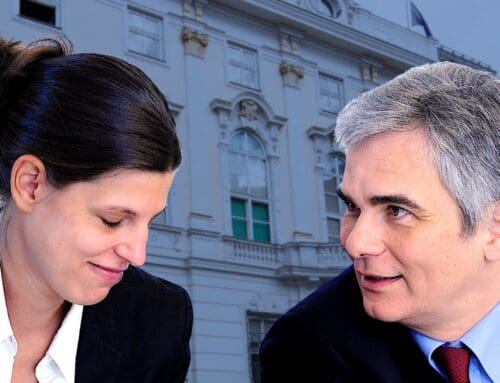
In The Fourth Industrial Revolution, Gene Editing Tools Are Likely to Replace Biological Evolution
This is part two of a series about the CRISPR/Cas gene editing system. In part one, which you can read HERE, we looked at who discovered and developed the system. Jennifer Doudna, in particular, has received many rewards and is touted as the “co-inventor” however ongoing disputes over patents would indicate otherwise.
In this part, we explore the World Economic Forum (“WEF”) and Bill Gates’ interests in CRISPR. As Doudna’s business interests seem to be intertwined with both, we begin with a brief description of the organisations she has founded.
We thank Threads Irish who has collected some research on this topic which proved useful for our own. It’s worth reading their article titled ‘Why Would Bill Gates & The World Economic Forum Be So Interested in CRISPR Technology? Prepare To Be Shocked’ as well as ours as it has additional information we have not included and vice versa.
Doudna the Founder and Scientific Advisor
In 2011, Doudna co-started Caribou Biosciences as what she calls “a research tool company” to exploit the possibility that CRISPR could be used to simplify the detection of viral infections like HIV. In September 2013, Doudna co-founded Editas Medicine but left after a falling out with Feng Zhang of the Broad Institute.
As detailed in part one, in 2012 the University of California, Berkeley, team led by Doudna filed a patent for CRISPR that was approved in 2019. The Broad Institute’s patent had previously been approved in 2014.
In 2014, Doudna founded the Innovative Genomics Institute (“IGI”) which uses “genome engineering to solve humanity’s greatest problems in health, climate, and sustainable agriculture.”
Genome engineering to “solve” climate? Genome engineering and climate don’t seem to be a logical fit in any one sentence, let alone when one is being touted as a solution for the other. But then “climate,” as in ‘Earth we have a problem’ type of climate, and “sustainability” are mantras incessantly used by supporters of the Fourth Industrial Revolution and Agenda 2030. Any organisation that peddles WEF mantras, especially when they seem to be used out of context, can be suspected of being World Economic Forum. If it looks like a duck and quacks like a duck, it’s probably a duck.
IGI began in 2014 through the Li Ka Shing Centre for Genetic Engineering, which was created thanks to a generous donation from the Li Ka Shing Foundation. The Innovative Genomics Initiative was formed as a partnership between the University of California, Berkeley and the University of California, San Francisco. The following year, “generous philanthropic donations enabled a bolder vision and broader mission” for the Initiative and in January 2017 it officially re-launched as the Innovative Genomics Institute. IGI’s funders now include DARPA, Chan Zuckerberg Initiative, Open Philanthropy, and Burroughs Wellcome Fund.
In 2015, Doudna became a founding member of Intellia Therapeutics, a spin-off from Caribou Biosciences. However, she is no longer on the management team of Intellia according to their website, although her own website states she is on Intellia’s scientific advisory board. In 2017, Doudna co-founded Mammoth Biosciences and Scribe Therapeutics.
As well as a founder as above, Jennifer A. Doudna (“J.A.D.”) is a scientific advisory board member of Vertex, Caribou Biosciences, Intellia Therapeutics, Scribe Therapeutics, Mammoth Biosciences, Algen Biotechnologies, Felix Biosciences, The Column Group and Inari.
She is also Chief Science Advisor to Sixth Street, a Director at Johnson & Johnson, Altos and Tempus, and has research projects sponsored by Biogen, Pfizer, AppleTree Partners and Roche.
The Doudna Lab currently has one project: the Centre for Genomic Editing and Recording (“CGER”), a collaboration between the Doudna, Joung, Liu and Weissman laboratories which is funded by the National Institutes of Health. CGER aims to build on CRISPR/Cas9 genome engineering to expand the ability to detect, alter and record the sequence and output of the genome in individual cells and tissues.
Further resources: Jennifer Doudna, Popular Timelines
Doudna and the World Economic Forum
The Malone Institute, in collaboration with the Pharos Foundation and Pharos Media Productions in Sweden, has invested months and hundreds of labour hours to mine existing and historic publicly available data sources to develop a detailed summary of graduates from two WEF training programs; Global Leaders of Tomorrow (a one-year program that ran from 1993 to 2003) and Young Global Leaders (a five-year program started 2004/2005 and still running).
Read more: Davos Man, his World Economic Forum, and his Servants
Doudna is not included in Dr. Malone’s database but, interestingly, her seemingly arch rival Feng Zhang, a core member of the Broad Institute of MIT and Harvard, enrolled as a Young Global Leader (“YGL”) in 2017. Even more interesting is that in their announcement of the class of 2017, WEF described Luhan Yang, chief scientist at eGenesis Biosciences, and Zhang as co-inventors of the CRISPR/Cas9 genome editing tool – not Doudna and Emmanuelle Charpentier.
Although Doudna was not YGL schooled, a search on WEF’s website shows that she became active on WEF’s site from January 2015. The first mention of her seems to be her participation in a Davos 2015 session titled ‘Rewriting Human Genes’.
Currently, Doudna and one of the companies she founded – Mammoth Biosciences – have a profile on the WEF website.
As an aside: You’ll note in the image above that one of Mammoth’s investors is 8VC whose founders are Drew Oetting and Joe Lonsdale.
8VC is a venture capital firm that is also one of the main investors in Resilience, the company that will be manufacturing the new version of Spikevax – Bivalent Spikevax – on behalf of Moderna. Oetting also sits on the board of Resilience and Lonsdale is the co-founder of Palantir, a CIA front company and intelligence contractor.
The founder of Moderna, Derrick Rossi, is also one of the founding members of Intellia Therapeutics as is Doudna. Rossi teamed up with Harvard’s George Church, who together with Zhang challenged Doudna’s claim to being the “inventor” of the CRISPR/Cas system. And Moderna is a WEF “associate” partner which has strategic agreements with AstraZeneca and Alexion Pharmaceuticals.
In February 2015, Doudna introduced WEF to her technology that “is revolutionising biology and offers the potential to cure human genetic disease.”
“Imagine that we had a tool whereby we could actually fix individual mutations in DNA, much like you would do with a word processor to cut and paste and edit text. What if we had a text editor for DNA in cells? It turns out that now we do,” she told the audience.
For all the claims Doudna made that her research is to find treatment for genetic diseases, WEF had different ideas. On 13 November 2015, Charlie Rose published a video interview with Schwab who said:
“You see the difference of this fourth industrial revolution is it doesn’t change what you are doing. It changes you, if you take genetic editing, just as an example. It’s you who are changing. And of course, this has a big impact on your identity.”
While on stage at Davos 2016 – with Klaus Schwab visibly titillated in anticipation of what she would say next – although still proclaiming that CRISPR should be used for the treatment of diseases caused by genetic mutations, Doudna said:
“I’m talking about being able to remove certain genes or mutations from the entire human species. [timestamp 08:09]
“We have the technology to [change genes that influence human behaviour], we just don’t have the knowledge to do it. We just don’t know enough about the human genome and the interaction of genes yet to be able to do it. [timestamp 26:50]
“I hope that in the future there will be ways to impact the way that we approach our lives in positive ways and perhaps controlling our DNA can help with that.” [timestamp 47:48]
In 2017, Doudna was named a member of WEF’s Life Science and Medical Faculty. We haven’t researched further to establish what exactly “faculty” means, whether it still exists or if Doudna is still a member.
At Davos 2019, the topic of ethical guidelines and safety standards for gene editing was raised. A reporter asked a question relating to experiments where Chinese researchers had cloned 5 monkeys for which they removed certain genes with the intent to cause serious mental illness. In answering, Victor Dzau said:
“There is research now being done on human brain cells implanted into animals where now the concern is you can have human conscious this hybrid research, chimaera research. Right? So, this is a whole field of ethics argument that needs to be vetted a lot more thorough than we are today.”
In mid-2019, WEF published an article indicating CRISPR is central to the Fourth Industrial Revolution:
“In the Fourth Industrial Revolution, new gene editing tools are likely to overtake biological evolution.
“In the Fourth Industrial Revolution, “satisfactory” may no longer be the status quo. We are now witnessing the most revolutionary stage of evolution, when we give up evolving by biology alone. With new life sciences tools such as CRISPR-Cas9 gene editing, we are now able to reshape genomes and alter biological form and function.
“The quest for human perfection through gene editing has already begun.”
Further reading: Human Augmentation Will Be the Death of Humanity
For an overview of WEF’s dystopian biotechnology plans, you can view a map of their “Strategic Intelligence” platform below or on WEF’s website HERE.
Doudna and Bill Gates
In 2021, Gates promoted a book written about Doudna called ‘The Code Breaker: Jennifer Doudna, Gene Editing, and the Future of the Human Race‘. He not only published an article on Gates Notes but also made one of his silly promotional videos.
“In 2016, I called The Gene: An Intimate History one of my favourite books of the year,” Gates wrote. This previous “favourite,” written by Siddhartha Mukherjee, was also about CRISPR. Gates said he was excited about these advances:
“Even before researchers successfully complete clinical trials in humans, genome editing will be put to good use in modifying plants and animals—all of which holds big promise for our foundation’s work.”
In 2021 Gates’ excitement went “off the charts”:
“In the five years since Mukherjee wrote his book, researchers have done a remarkable job of honing the CRISPR system for medical and agricultural applications, and my excitement about CRISPR has grown from super high to off the charts … Thanks to the CRISPR system, it’s very likely that our grantees will be able to develop much more effective [malaria] vaccines in the next five years.
“The foundation is investing in many other projects that use the CRISPR system, such as:
- plant varieties that can withstand the effects of climate change
- a new suite of tools called programmable medical therapies, which could greatly speed up the development of treatments for new viruses and head off future pandemics
- quick, inexpensive ways of diagnosing diseases in poor countries
- monoclonal antibodies that could target and kill the pathogens that cause malaria and AIDS.
“While the foundation is not funding any CRISPR projects that involve germline editing, Doudna says it doesn’t make sense to ban germline editing outright.”
In 2016, WEF published an article by Deane F. and Kate Edelman Johnson Professor of Law, Stanford University which indicates Gates and WEF were singing from the same hymn sheet:
“Imagine a world with less expensive and more resilient crops, plants that can meet the world’s need for liquid biofuels, no more malaria-carrying mosquitos, real blue roses, living woolly mammoths, unicorns and a few devastating new plagues. These fantasies may before long become realities through the use of a biomolecular tool called CRISPR/Cas9 or its descendants.
“Many of these non-human uses take on greater significance in light of a related development called “gene drive”. It speeds up the passage of a modified gene through a wild population of, say, mosquitos by using CRISPR/Cas9 not only to modify the first generation, but by having the same CRISPR/Cas9 complex stay active in all subsequent generations. This converts the “normal” genes inherited from an unmodified mosquito parent into the desired modified form. As a result, the modified gene might spread through the entire population very quickly, perhaps before anyone even knows what is happening.” [emphasis our own]
In a 2018 TED speech, WEF Young Global Leader Fredros Okumu, Director of Science at Ifakara Health Institute in Tanzania, said that WHO had set a goal of 2030 to eliminate malaria from 35 countries and “the African Union has set a goal of 2030 to eliminate Malaria from the continent. At Ifakara we are firmly behind these goals.”
When asked what he thought about scientists using CRISPR to kill off mosquitoes, Okumu responded:
“There are countries that have reduced 60% reduction in malaria burden, but we still have to do more to get to zero.
“There is already proof of principle that gene-editing techniques such as CRISPR can be used effectively to transform mosquitoes so that either they do not transmit malaria, we call this population alteration, or that they no longer exist – population suppression … There is even proof that if you were to release just a small number of genetically modified mosquitoes that you can actually achieve elimination very quickly.
“So, CRISPR and tools like this offer us some real opportunities, real-life opportunities, to have high-impact interventions that we can use in addition to what we have now to eventually go to zero.”
You can watch Okumu’s speech in the video below, we have embedded it to begin at timestamp 08:19.
As noted by Threads Irish, Gates has poured millions into CRISPR. In 2015, Gates and 13 other investors poured $120 million into gene editing start-up Editas Medicine. Editas Medicine was founded in 2014 by Zhang, Doudna and three scientists from Harvard University – George Church, David Liu, and J. Keith Joung. Church previously teamed up with Moderna’s founder Rossi and both Liu and Joung’s laboratories are in collaboration with CGER – the only current project of Doudna’s lab. Doudna left Editas in June 2014, the following year it was named a 2015 technology pioneer by WEF
Gates has also donated to Edge Animal Health, CRISPR Therapeutics, Acceligen, Inc and numerous universities that research it, including Stanford University. The grant to Edge Animal Health is to fund the development of livestock vaccines using CRISPR/Cas. Edge’s website is still to go live.
The grant to Accellegen is to provide small-scale dairy producers in sub-Saharan Africa access to “highly-productive and well-adapted cows.” In March, Accelligen was given FDA approval for CRISPR gene-edited beef. Based on a trial of two cows, the FDA determined no safety signals.
CRISPR to Hijack Our Immune Cells
We include this section as an indication of how far Doudna’s ethical position has shifted from her original view of using CRISPR to only treat genetic diseases to one of taking control over the human genome. In an interview with Bloomberg last year, Doudna said:
“[Studying] the function of a protein known as CRISP/Cas9 … led to an understanding of the function of this molecule that allowed us to harness it as a tool for genetic manipulation – namely, for altering DNA sequences in any cell in a precise fashion in a programmable fashion. That gives scientists now a very powerful way to understand the function of genes but importantly also to change the function of genes in a targeted way. [timestamp 05:24]
When asked if we could educate our immune systems ahead of time to be ready just in case a virus “shows up,” Doudna responded:
“It’s a tricky thing because you have to know what to be ready for … We’re seeing opportunities to use CRISPR to edit immune cells and then this is being done in conjunction with cancer immunotherapy for patients, for example, so you could imagine taking that a step further and saying well can we educate our immune cells to be ready for a virus.” [timestamp 19:31]
Educate our immune cells? With artificial immune cells? They are gaslighting our natural immunity. We have innate immune systems which are ready just in case any number of pathogens, not just viruses, “show up.” How do they think the human race has survived thus far?
Unfortunately, Doudna’s “educate our immune cells” statement wasn’t simply a comment made in passing. In July 2022, IGI published an article about mapping how complex networks of genes function together. Researchers have “created the most detailed map yet … The new insights into how these genes relate to each other shed light on both the basic drivers of immune cell function and on immune diseases.”
These results help us flesh out a systematic network map that can serve as an instruction manual for how human immune cells function and how we can engineer them for our benefit,” says Alex Marson, MD, PhD, Director of Human Health at IGI, Director of the Gladstone-UCSF Institute of Genomic Immunology and co-senior author of the new study, published in Nature Genetics.
We really wanted to look at what is controlling key immune genes,” says Jacob Freimer, PhD, a postdoctoral fellow in both the Marson and Pritchard labs, and first author of the new paper.
Freimer and his collaborators turned to the CRISPR/Cas9 gene editing system, which allowed them to disrupt thousands of genes at once. They concentrated on genes that make a type of proteins known as transcription factors. Transcription factors are the switches that turn other genes on or off and can control many genes at once.
The new map helped reveal how genetic changes associated with [immune] diseases can appear in different genes but – because of regulatory connections between genes – end up having the same net effect on cells. It also points to key groups of genes that might be targeted by drugs to treat immune diseases. The study suggests there’s a central network of important genes, and when this network is perturbed, it can increase a person’s disease risk. [emphasis our own]
Scientists Map Networks of Disease-Associated Immune Genes, Innovative Genomics Institute, 14 July 2022
How many of those “important genes” will their CRISPR/Cas system either inadvertently or deliberately perturb? And how many other networks and important genes have they not yet discovered? Our guess would be however much they think they know they know very little. Every genetic modification, every gene edit they are doing is an experiment, it’s only the scale and whether it is conducted in, or outside, a laboratory that differs. They are bioterrorists – all of them. Doudna, Zhang, Gates, Schwab – all of them are bioterrorists. Their gene experiments on plants, animals and humans are a danger to all life and should be halted immediately. Let nature prevail.










